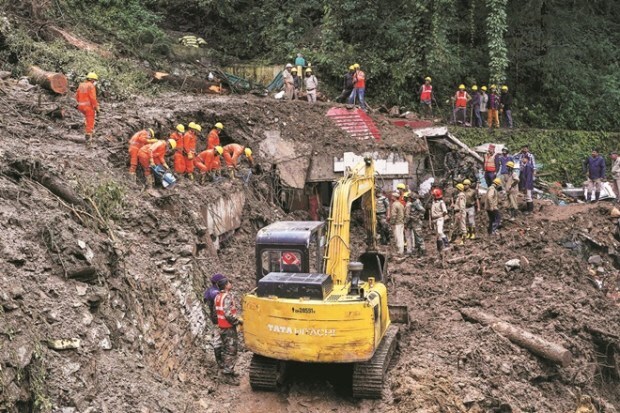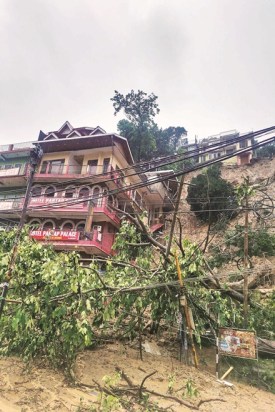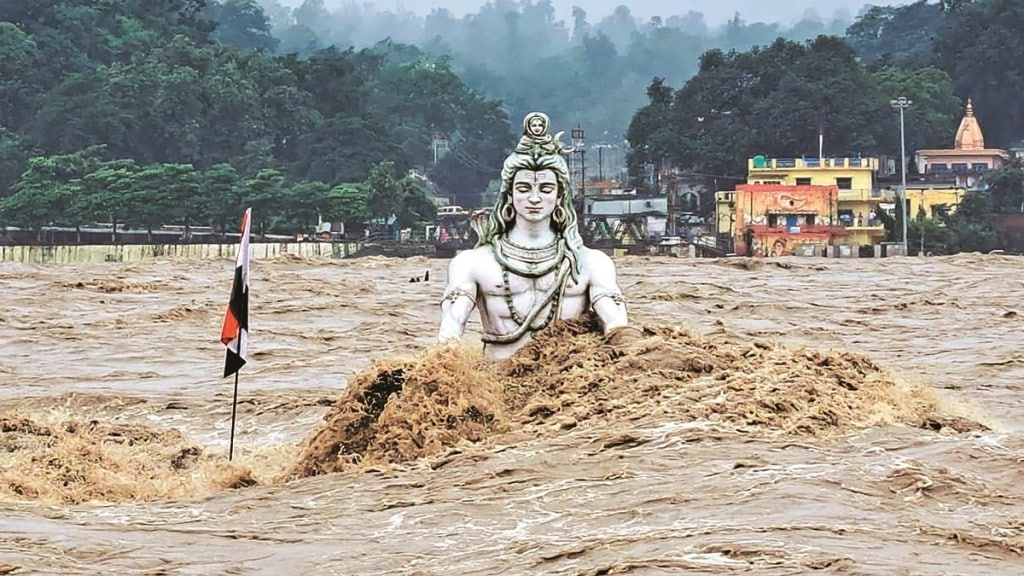This year, the monsoon has not been kind to the states straddling the Himalayas in northern India. Just a month after record showers killed more than 100 people over two weeks in parts of the region, heavy rains that began over the weekend on August 12 once again triggered floods and landslides, leaving at least 81 people dead and many others affected.
Among the worst hit is Himachal Pradesh. On August 14, a Shiv Temple near Summerhill in Shimla bore the brunt of devastating rains after it collapsed due to a landslide, leaving nine dead and dozens trapped in the debris. With this, the toll of landslides and other weather-related events in recent days in Himachal Pradesh has reached 74, as per officials.
Similarly, in nearby Uttarakhand, which is yet to recover from the horrors of the 2021 flash floods that killed nearly 200 people and washed away several houses, several people have died in the monsoon rains this season, as per reports.
While floods and landslides, and the resultant devastation, during the monsoon season in these parts of the country are not uncommon, experts say the climate crisis is increasing their frequency and severity.
Tectonic shift
Fresh cracks have reportedly appeared in Joshimath, with the existing ones widening, as heavy rains once again batter Uttarakhand.
Earlier this year, the Himalayan town saw the displacement of hundreds of inhabitants after their houses developed cracks with varying degrees of damage. Eventually, over 700 of the approximately 4,500 structures, along with the streets and paved areas, in the area showed cracking. Work began on January 9 to demolish the unsafe buildings.
Located at an altitude of 6,150 feet, Joshimath is the gateway to several Himalayan climbing expeditions, trekking trails and pilgrim centres like Badrinath. Experts cite years of unplanned construction, over-population, obstruction of the natural flow of water and hydel power activities as possible causes for the land subsidence that is causing the gradual sinking of the town.
Dr Shresth Tayal, senior fellow, Centre for Himalayan Ecology, The Energy and Resources Institute (TERI) School of Advanced Studies, says: “Joshimath is a tectonically active seismic zone. The anthropogenic pressure by private and government construction work has triggered the present situation.”
Simply put, be it Shimla, Joshimath or any other place in northern India, such extreme events are repeatedly signalling the ecological mess in the Himalayas. If monsoon furies have left the hills and states battered, then unplanned construction, urbanisation and overdependence on tourism have wreaked havoc, further disturbing the ecological balance of nature. Even if all of this is not new, just the sheer number of climate threats that these major hotspots have now witnessed in the past few years seems to be a bit more than a warning.
So, why is north India frequently witnessing such disasters? Tayal of TERI School of Advanced Studies shares a brief history of the Himalayas and the reasons for the disasters.
“The Himalayan rocks are naturally vulnerable in comparison to south India. The Himalayas are typically young mountains, weak and recently developed ranges, made of sedimentary rocks. So, landslides happen more often in the rainy season and are quite common in this terrain. But in the recent past we have heard of cloudbursts, degradation of land, etc. The natural vulnerability of such events has increased and is enforced with man-made construction or climate change, thus increasing the intensity of the impact being felt all over the places,” he explains.
Another reason is the deforestation for land use or construction purposes that has made the hills very weak. “With the increase in these activities, and big projects, the construction of tunnels is making these mountains unstable. It is important to study and investigate the impact on mountains,” adds Tayal.

Bhaskar Padigala, head-climate change hub, WWF India, agrees: “The Indian Himalayan region is extremely fragile. Rising temperatures, receding glaciers, changing precipitation patterns, and an increase in the frequency of extreme weather events pose significant threats to the region’s fragile ecosystems, biodiversity and the lives of millions of people.”
Several studies have shown that rapid melting of glaciers in the Himalayas are creating abrupt floods, causing significant harm to life and property. These glacier retreats are also resulting in the creation of glacial lakes, which pose potential dangers to the downstream population.
As per Padigala, these glacier lakes can burst and cause massive destruction to people’s lives and property, known as ‘glacial lake outburst flooding’ (GLOF). “River basins in the Western Himalayas are primarily fed by snow and glacial melt, with rainfall originating primarily from wintertime western disturbances. However, with the increase in extreme rainfall events and several artificial obstructions due to construction and debris dumping, the behaviour of Himalayan rivers is becoming unpredictable,” he adds.

Changing patterns
This year, Europe is seeing a dramatic change in weather conditions. In many parts of the continent, temperatures are soaring above 40 degrees Celsius. Wildfires have been raging throughout Greece, and certain parts of southern Spain saw record-breaking temperatures of 60 degrees Celsius. Sweltering conditions also prevailed in France, Switzerland and Germany.
The role of climate change in India is also overwhelming. It has affected the normal circulation of winds, impacted weather patterns.
“From the drizzle for a week about a decade ago, now we see intense rains for a day. This has given rise to extreme precipitation and such events have tremendously increased over the years. The number of heavy rainfall events has also increased,” adds Tayal of TERI School of Advanced Studies.
Rajasthan, Delhi, Punjab, Haryana, Jammu & Kashmir, Uttarakhand and Himachal Pradesh have witnessed intense weather patterns with the monsoon season becoming more erratic and less dependable. Rivers have a limited capacity and if water goes beyond the capacity, it is bound to affect the cities.
In March, the 23rd report on glacier management and monitoring of the Parliamentary Standing Committee on Water Resources highlighted that the Himalayan-Karakoram region is warming faster than global mean by 0.5 degrees Celsius and stated the ‘majority of Himalayan glaciers are observing melting/ retreating at varying rates in different regions’.

India Meteorological Department (IMD) data, too, shows that Delhi received ‘excess’ rain in July, recording showers on 19 of the 31 days in the month. The capital city received 384.66mm rainfall over the course of the month—the third most for July in the past two decades.
Naturally, the situation is having a detrimental effect on the livelihoods of those who rely on tourism in these areas. “The government and rescue teams are diligently working to minimise the damage caused by the natural calamity. Such disasters strongly affect the mood in the tourism sector in a big way and the after-effects linger on for quite some time before things get back on track. Recent statements from the Himachal Pradesh government also state the overall loss to the state’s exchequer was Rs 8,000 crore. This figure can increase further due to ripple effects and normalcy in the affected areas shall depend on the pace of basic infrastructure recovery,” says Tejinder Gupta, partner, public sector, Grant Thornton Bharat, who has worked with the tourism ministry in India including some flagship programmes like Namchi smart city in Sikkim.
According to Dr Reena Singh, senior fellow, Indian Council for Research on International Economic Relations (ICRIER), unplanned urbanisation is causing enormous changes in land use and land cover, as a result of which spring recharge areas are being reduced, causing water insecurity in hill towns.
“Climate-induced changes have been observed like increased rainfall variability and frequent rainfall and these lead to more landslides. Global warming has increased the average temperature in the Himalayas causing glaciers to melt and subsequent change in hydrological regimes of the region. Deposition of black carbon, which is caused by crop residue burning in Punjab, is one of the contributing factors of glacier decline. These critical stressors are adversely affecting the socio-ecology of the Himalayan region. While natural water bodies are degrading and traditional water systems such as springs are evidently disappearing, the demand for water has increased greatly in these urban towns mainly due to floating population, particularly in peak tourist seasons, challenging the carrying capacities of the towns,” she says.
Some scientists attribute the current changes in climate worldwide to the natural phenomenon of EL Nino, which is estimated to cause global economic losses of $3 trillion, according to international studies, coupled with climate change.
“Apart from the economic losses resulting from decreased agricultural production and manufacturing, the heat wave resulting from climate change is bound to be detrimental for the health and well-being of a large chunk of population as well as the environment. It’s a catch-22 situation where one is impacted by another while forming a vicious circle that mankind is unable to break or cope up with,” adds Delhi-based Kamal Narayan, CEO, IHW Council, Integrated Health & Wellbeing (IHW) Council, a think tank engaged institution for health awareness, advocacy and behaviour change.
Preventing disasters
The recent devastation caused by flash floods in northern India, especially in the mountains, has shed light on the infrastructural planning inefficiencies and their effects on the land. The ever-increasing haphazard and unplanned construction in eco-sensitive mountainous terrain can cause natural disasters like flash floods, ground instability, landslides and sinking of ground. Increasing infrastructure can weaken the soil structure and the ground, weakening foundations. Experts feel using design solutions and interventions for resisting and withstanding the impacts of flash floods are becoming necessary while designing in the mountains.
“Designing in eco-sensitive areas requires research and planning with tailored design solutions based on the site location, topography, climate and function.
Meticulous analysis and the right design interventions can create mindful eco-sensitive, homogeneous structures that mitigate drastic negative environmental effects,” says Gian P Mathur, managing director, GPM Architects & Planners, a design consultancy firm in Delhi.
The problem also arises when the construction in these areas is mimicked to that of typical city structures. A conventional construction inherently means cutting and filling the land, leading to soil destabilisation and pushing an already fragile ecosystem to the brink.
“While the labour and materials for such construction are easily available, any construction technique used in the hills must centre on allowing the water to flow naturally, with minimal obstruction. Urban planning policy for mountainous regions must be framed around this and other necessary ecologically sensitive considerations. An adaptable framework that links the nature of construction allowed to the slope gradient and defining unbuildable zones over a certain gradient will greatly minimise cut-and-fill, helping the land retain its stability,” says Sidhartha Talwar, founding principal, Studio Lotus, an infrastructure development company that has developed projects in Uttarakhand.
While urban growth is unavoidable, efforts should be made, however, to steer it in a more sustainable path via integrated urban-rural land use planning. Effective land use policies must be developed and properly executed in order to maintain and conserve forests, biodiversity, water resources and agricultural land. Municipal bylaws must provide for regulating construction activities in areas that fall in hazard zones or areas close to rivers and watersheds of the towns. In many cases these provisions exist in the bylaws but need to be strictly enforced.
“Growing rural outmigration, better road connectivity, market access and an unprecedented growth of tourism have resulted in a massive increase in the size, area, number and complexity of Himalayan urban towns. For example, the urban population of Uttarakhand increased from 16.3% in 1971 to 30% in 2011. This rapid urbanisation is accompanied by an increase in urban infrastructure in both cities and the peri-urban areas,” says Padigala of WWF India.
Furthermore, rising urbanisation has limited a town’s current capability as they struggle to provide basic services such as water and sanitation, leaving little time and resources to manage urban expansion and its associated risks. As a result, the built-up area of these mountain towns/cities has risen dramatically in recent decades, with the majority of construction coming up in environmentally risky zones, particularly landslide and flood-prone places.
The Uttarakhand floods in 2013 and the recent situation in Himachal Pradesh are stark reminders of the enormity of losses. So, more emphasis should be placed on nature-based solutions to enhance the grey infrastructure for disaster resilience. “Akin to how mangroves protect coastal areas, afforestation and reforestation of mountains can prevent soil erosion and absorb water—contributing to flood mitigation. Traditional practices and community-led initiatives have proven to be harmonious with natural settings and must be encouraged,” says Tejashree Joshi, head environmental sustainability, Godrej & Boyce.
Methods like agro forestry, which integrate trees into crop and livestock systems, can help manage water, soil and nutrient cycles. “This not only reduces risks from hydro-met disasters but also aids in building resilient livelihoods. It is upon stakeholder groups—government and non-government, private sector and citizens to act and change the course of the future that is predicted for us,” adds Joshi.
For the hills to support local infrastructure, seasonal migration or over tourism has to be controlled. People will need to adopt a sustainable approach to tourism and construction cycle and restrict the number of tourists in the state. “If the rise in the construction of hotels, houses and facilities has made good arrangements for the livelihood of the local people, stakeholders must regulate it and build the capacity of the local communities. Mountain-friendly construction material and activities are required and the carrying capacity of the mountains need to restricted,” says Tayal.
Infrastructure projects such as roads, tunnels and ropeways will have to be built based on scientific assessments from a geological and climate point of view. Proper land use planning and infrastructure design will be crucial in minimising loss and damage.
As extreme climate events are likely to become more common in the future, policymakers and other stakeholders must learn from past experiences to ensure that development in the mountains is sustainable and climate resilient.
Padigala feels that there is a need to develop and implement effective climate resilient strategies in the Himalayan region. “These strategies should prioritise decreasing GHG (greenhouse gas) emissions through the use of renewables, check black carbon emissions, strengthen community resilience through nature-based solutions (NbS), and support sustainable development that is compatible with the region’s distinctive natural and cultural heritage. The region can achieve a more sustainable and climate-resilient development by leveraging local knowledge, scientific information and collaboration among the stakeholders,” he adds.
Recently, a committee headed by Uttarakhand chief secretary has suggested regulation of tourist inflow to the hill station of Mussoorie in proportion to the carrying capacity of the region, and that the “unplanned urbanisation driven by haphazard construction and infrastructure development poses significant risks, including building collapses and disasters during heavy rainfall and earthquakes”. Experts claim that the entire city is getting into bad shape.
Recently, the Supreme Court stressed the need for maintaining a balance between development and environment in Shimla for its unplanned and indiscriminate development coupled with encroachments on water bodies in the core, non-core, green and rural areas had given rise to serious environmental and ecological concerns.
The Road Ahead
- Infrastructure projects such as roads, tunnels and ropeways will have to be built based on scientific assessments from a geological and climate point of view
- Proper land use planning and infrastructure design will be crucial in minimising loss and damage
- Meticulous analysis and right design interventions can create mindful, eco-sensitive, homogeneous structures that mitigate drastic negative environmental effects
- Construction technique used in the hills must centre on allowing the water to flow naturally, with minimal obstruction
- Local materials like stones and wood are viable alternatives for building resilient structures
- Proper drainage system for waste water and sewage is required, not reliance on soak pits that percolate to the ground and push soil sediments, thus causing subsidence
Global warming has increased the average temperature in the Himalayas causing glaciers to melt and subsequently changing the hydrological regimes of the region
— Dr Reena Singh, senior fellow, ICRIER
The Himalayas are young mountains, made of sedimentary rocks. So, landslides happen more often in the rainy season. The natural vulnerability of these events is increasing due to climate change
— Dr Shresth Tayal, TERI School of Advanced Studies







